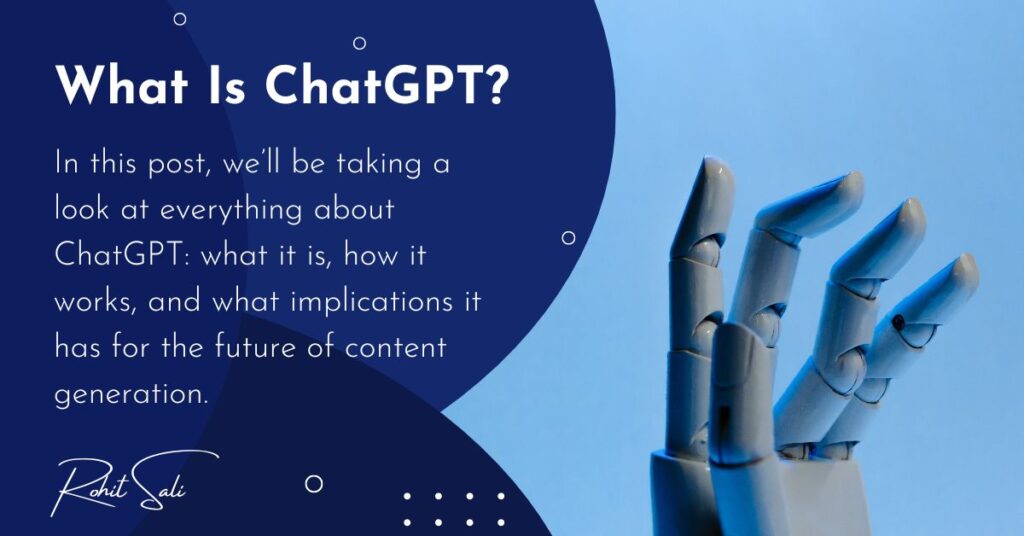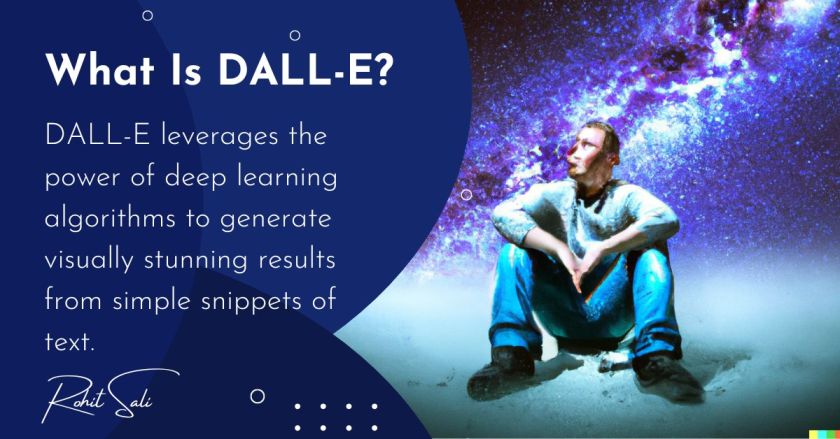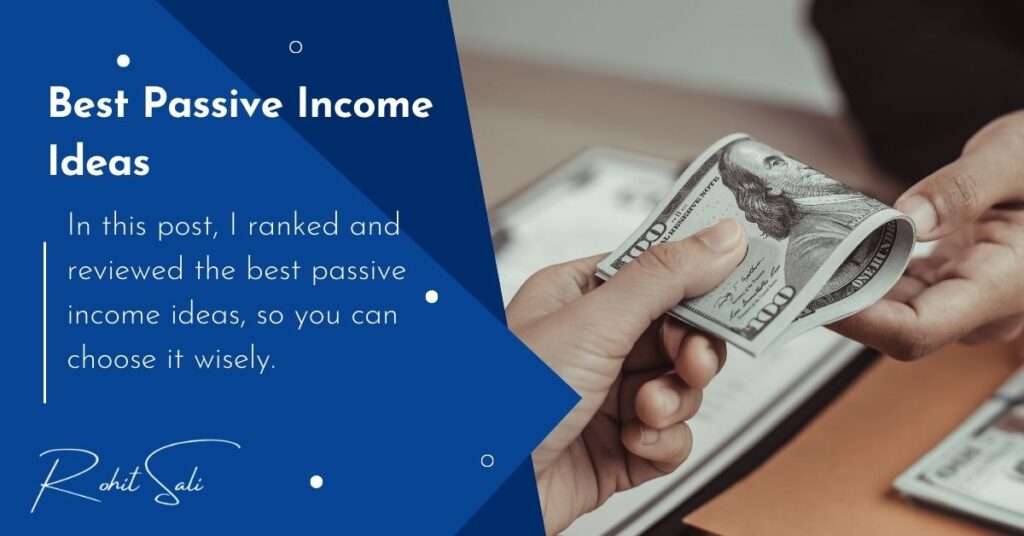Did you know that there’s a chatbot out there that can generate text content on any topic?
Well, there is, and it’s called ChatGPT.
In this post, we’ll be taking a look at everything about ChatGPT: what it is, how it works, and what implications it has for the future of a content generation.
So whether you’re a tech-savvy individual who’s curious about the latest artificial intelligence advancements or just someone who wants to know more about this cool new technology.
We can also make money with ChatGPT, by using it wisely.
Let’s start.
What Is ChatGPT?
ChatGPT is an open-source, conditional language generation (CLG) model released by OpenAI.
It’s based on the GPT-3 architecture and has been trained to generate human-readable text for general use cases.
The idea behind ChatGPT is that it can take input in natural languages – such as a question or prompt – and then generate a response based on that input. This means that users can have conversations with ChatGPT just as they would with any other person, except this one is completely automated.
Additionally, ChatGPT has been trained to generate text content in multiple genres, including technical documentation, fiction, and creative nonfiction.
This means that it can be used for a variety of different purposes, from providing technical support to writing blog posts or stories.
How Does ChatGPT Work?
ChatGPT is powered by the GPT-3 language model, which stands for Generative Pre-trained Transformer 3.
The GPT-3 model is a deep learning model that has been trained on a massive set of texts, such as books, blogs, and other content sources.
By feeding input into the GPT-3 language model, ChatGPT is able to generate text in response to whatever input is given. This process is called conditional language generation (CLG).
What Makes ChatGPT So Special?
ChatGPT is a powerful tool for content generation, but what makes it truly special is the fact that it’s open source.
This means that anyone can use and modify the code, allowing developers to create their own custom versions of ChatGPT for specific applications or tasks.
In addition, ChatGPT is powered by GPT-3, which means it has access to an immense amount of pre-trained data. This allows ChatGPT to generate text with greater accuracy and fluency than other models.
What Are The Key Features of ChatGPT?
The key features of ChatGPT include:
- Ability to generate text in multiple genres and topics.
- Open source code, allowing anyone to customize it for their own needs.
- Powered by GPT-3, giving it access to a massive amount of pre-trained data.
- Can generate human-readable text based on user input.
What Are the Pros And Cons Of ChatGPT?
Pros
- Easy to use and customize.
- Can generate text based on user input, allowing for more natural conversations.
- Access to a massive amount of pre-trained data, resulting in more accurate and fluent output.
Cons
- Some errors occur due to the lack of context provided by the user input.
- Not suitable for very complex tasks or specialized topics.
What Are Limitaions of ChatGPT?
ChatGPT is a powerful tool for content generation, but it does have its limitations.
For example, ChatGPT cannot generate text about very complex topics or specialized areas of knowledge.
It is not able to generate text with the same level of nuance and subtlety as a human writer.
Furthermore, ChatGPT requires some input from the user in order to generate a response, so it cannot operate autonomously. This means that if the user does not provide enough context or information, ChatGPT may generate incorrect or incomplete responses.
Finally, ChatGPT is based on an open-source framework, and as such may be vulnerable to malicious attacks or modifications. It is important to ensure that ChatGPT is maintained and updated regularly in order to reduce the risk of any security issues.
What Can You Do With ChatGPT?
ChatGPT can be used for a variety of tasks, such as content generation, customer service automation, and even creative writing.
It is capable of generating text in multiple genres, including technical documentation, fiction, and creative nonfiction.
This means that it can be used for a range of purposes, from providing technical support to writing blog posts or stories.
ChatGPT has been trained to generate human-readable responses based on user input, allowing for more natural conversations.
What Are Implications Of ChatGPT
The implications of ChatGPT are far-reaching and could have a major impact on the way we create content.
For example, it could be used to automate mundane tasks such as creating technical documentation or writing blog posts that require research and analysis.
With its ability to generate content in various genres, ChatGPT could be used for creative purposes such as writing stories or creating original music.
ChatGPT could also be used to create personalized content for customers and clients, helping businesses build stronger relationships with their customers.
ChatGPT could be integrated into existing applications such as customer support chatbots, allowing businesses to provide more natural conversations with customers.
Finally, ChatGPT could even lead to the development of artificial intelligence-driven copywriters, reducing the need for human writers in certain industries.
Overall, ChatGPT is a powerful tool that has potential applications across many different areas and industries. While it still has some limitations and risks associated with its use, it can be an invaluable asset when used properly.
AI Art And ChatGPT
AI art is becoming increasingly popular and can be used in conjunction with ChatGPT to generate visually impressive images.
By using natural language input into ChatGPT, users can ask for specific image descriptions and fine-tune the details until they get exactly what they’re looking for.
This could have applications across a variety of disciplines such as animation, digital art, and even architecture.
In conclusion, AI art and ChatGPT make a powerful combination that could lead to incredible results when used correctly.
With its ability to generate custom content based on user inputs, ChatGPT could be invaluable for creating AI-generated visual works of art.
It could also be used in other ways such as by providing automated customer service or even creating original music. With its potential, ChatGPT could be a game-changer for many industries in the near future
How To Use ChatGPT?
- To Use ChatGPT go to the official website, create an account, and log in.
- Once logged in, you can start by providing the input that ChatGPT needs to generate a response.
- It is important to provide enough context and information for ChatGPT to understand what it needs to do.
- You can also customize the output by adjusting certain parameters such as content length, complexity level, and even the genre of the output.
- Once you are satisfied with the result, you can save it and use it as needed.
- ConclusionChatGPT is a powerful tool that could revolutionize many industries, from customer service to digital art.
- It has potential applications across multiple fields and can be used for tasks ranging from content generation to creative writing.
ChatGPT can be used in a variety of ways, depending on the task.
What Is ChatGPT – FAQs
ChatGPT is an AI-powered chatbot that utilizes natural language processing (NLP) to generate responses based on user input. It can be used for a variety of tasks, such as content creation, customer service automation, and even creative writing.
While powerful, ChatGPT has some limitations that must be taken into account when using it. Firstly, it is not able to generate text with the same level of nuance and subtlety as a human writer. Additionally, ChatGPT requires some input from the user in order to generate a response, so it cannot operate autonomously.
The implications of ChatGPT could be far-reaching, as it has potential applications across many different industries and disciplines. It could be used to automate mundane tasks such as content creation or customer service, or for more creative activities such as writing stories or creating artificial art. Additionally, it could be integrated into existing applications to provide more natural conversations with customers.
AI art can be used in conjunction with ChatGPT to generate visually impressive images using natural language input from the user. This technique could have a variety of applications, from animation and digital art to architectural design. When used correctly, AI art and ChatGPT could lead to incredible results.
Wrap Up
In summary, ChatGPT is a powerful tool for natural language processing that could have immense potential applications.
It can be used to generate content in various genres, create personalized customer responses, and even generate AI art.
While it does have some risks associated with its use, these can be minimized with proper maintenance and security.
In the near future, ChatGPT could potentially revolutionize many industries by automating mundane tasks or creating stunning visuals.
Ultimately, the possibilities are endless and ChatGPT could prove to be a valuable asset for businesses and individuals alike.




